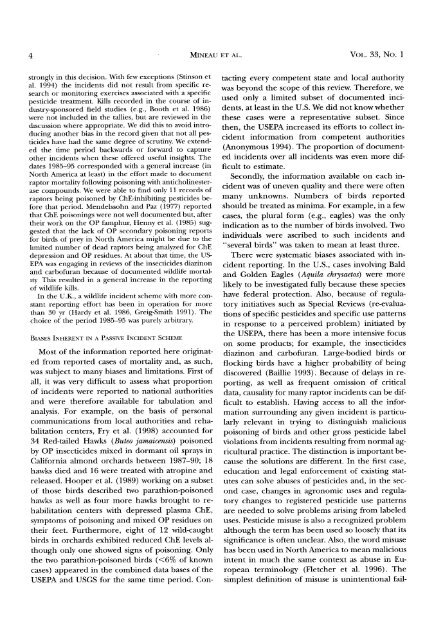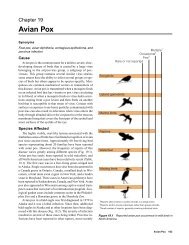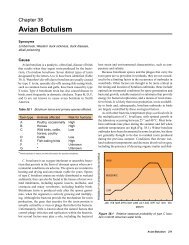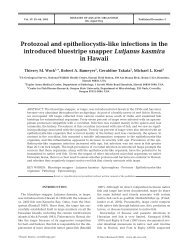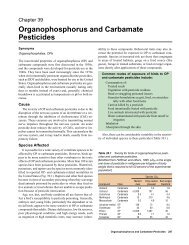poisoning of raptors with organophosphorus and carbamate ...
poisoning of raptors with organophosphorus and carbamate ...
poisoning of raptors with organophosphorus and carbamate ...
You also want an ePaper? Increase the reach of your titles
YUMPU automatically turns print PDFs into web optimized ePapers that Google loves.
4 M•NE^U ET AL. VOL. 33, NO. 1<br />
strongly in this decision. With few exceptions (Stinson et tacting every competent state <strong>and</strong> local authority<br />
al. 1994) the incidents did not result from specific rewas<br />
beyond the scope <strong>of</strong> this review. Therefore, we<br />
search or monitoring exercises associated <strong>with</strong> a specific<br />
pesticide treatment. Kills recorded in the course <strong>of</strong> in- used only a limited subset <strong>of</strong> documented incidustry-sponsored<br />
field studies (e.g., Booth et al. 1986) dents, at least in the U.S. We did not know whether<br />
were not included in the tallies, but are reviewed in the these cases were a representative subset. Since<br />
d•scussion where appropriate. We did this to avoid intro- then, the USEPA increased its efforts to collect inducing<br />
another bias in the record given that not all pescident<br />
information from competent authorities<br />
ticides have had the same degree <strong>of</strong> scrutiny. We extended<br />
the time period backwards or forward to capture (Anonymous 1994). The proportion <strong>of</strong> documentother<br />
incidents when these <strong>of</strong>fered useful insights. The ed incidents over all incidents was even more difdates<br />
1985-95 corresponded <strong>with</strong> a general increase (in ficult to estimate.<br />
North America at least) in the effort made to document Secondly, the information available on each inraptor<br />
mortality following <strong>poisoning</strong> <strong>with</strong> anticholinestercident<br />
was <strong>of</strong> uneven quality <strong>and</strong> there were <strong>of</strong>ten<br />
ase compounds. We were able to find only 11 records <strong>of</strong><br />
<strong>raptors</strong> being poisoned by ChE-inhibifing pesticides be- many unknowns. Numbers <strong>of</strong> birds reported<br />
tbre that period. Mendelssohn <strong>and</strong> Paz (1977) reported should be treated as minima. For example, in a few<br />
that ChE <strong>poisoning</strong>s were not well documented but, after cases, the plural form (e.g., eagles) was the only<br />
their work on the OP famphur, Henny et al. (1985) sug- indication as to the number <strong>of</strong> birds involved. Two<br />
gested that the lack <strong>of</strong> OP secondary <strong>poisoning</strong> reports individuals were ascribed to such incidents <strong>and</strong><br />
tbr birds <strong>of</strong> prey in North America might be due to the<br />
"several birds" was taken to mean at least three.<br />
hmited number <strong>of</strong> dead <strong>raptors</strong> being analyzed for ChE<br />
depression <strong>and</strong> OP residues. At about that time, the US- There were systematic biases associated <strong>with</strong> in-<br />
EPA was engaging in reviews <strong>of</strong> the insecticides diazinon cident reporting. In the U.S., cases involving Bald<br />
<strong>and</strong> carb<strong>of</strong>uran because <strong>of</strong> documented wildlife mortal<strong>and</strong><br />
Golden Eagles (Aquila chrysaetos) were more<br />
•ty This resulted in a general increase in the reporting<br />
<strong>of</strong> wildlife kills.<br />
likely to be investigated fully because these species<br />
In the U.K., a wildlife incident scheme <strong>with</strong> more constant<br />
reporting effort has been in operation for more<br />
have federal protection. Also, because <strong>of</strong> regulatory<br />
initiatives such as Special Reviews (re-evaluathan<br />
30 yr (Hardy et al. 1986, Greig-Smith 1991). The tions <strong>of</strong> specific pesticides <strong>and</strong> specific use patterns<br />
choice <strong>of</strong> the period 1985-95 was purely arbitrary.<br />
in response to a perceived problem) initiated by<br />
BIASES INHERENT IN A PASSIVE INCIDENT SCHEME<br />
Most <strong>of</strong> the information reported here originated<br />
from reported cases <strong>of</strong> mortality <strong>and</strong>, as such,<br />
was subject to many biases <strong>and</strong> limitations. First <strong>of</strong><br />
all, it was very difficult to assess what proportion<br />
<strong>of</strong> incidents were reported to national authorities<br />
the USEPA, there has been a more intensive focus<br />
on some products; for example, the insecticides<br />
diazinon <strong>and</strong> carb<strong>of</strong>uran. Large-bodied birds or<br />
flocking birds have a higher probability <strong>of</strong> being<br />
discovered (Baillie 1993). Because <strong>of</strong> delays in reporting,<br />
as well as frequent omission <strong>of</strong> critical<br />
data, causality for many raptor incidents can be dif<strong>and</strong><br />
were therefore available for tabulation <strong>and</strong> ficult to establish. Having access to all the inforanalysis.<br />
For example, on the basis <strong>of</strong> personal mation surrounding any given incident is particucommunications<br />
from local authorities <strong>and</strong> rehalarly<br />
relevant in trying to distinguish malicious<br />
bfiitation centers, Fry et al. (1998) accounted for<br />
34 Red-tailed Hawks (Buteo jamaicensis) poisoned<br />
by OP insecticides mixed in dormant oil sprays in<br />
<strong>poisoning</strong> <strong>of</strong> birds <strong>and</strong> other gross pesticide label<br />
violations from incidents resulting froin normal agricultural<br />
practice. The distinction is important be-<br />
California almond orchards between 1987-90; 18 cause the solutions are different. In the first case,<br />
hawks died <strong>and</strong> 16 were treated <strong>with</strong> attopine <strong>and</strong> education <strong>and</strong> legal enforcement <strong>of</strong> existing statreleased.<br />
Hooper et al. (1989) working on a subset utes can solve abuses <strong>of</strong> pesticides <strong>and</strong>, in the sec<strong>of</strong><br />
those birds described two parathion-poisoned ond case, changes in agronomic uses <strong>and</strong> regulahawks<br />
as well as four more hawks brought to rehabilitation<br />
centers <strong>with</strong> depressed plasma ChE,<br />
sy•nptoms <strong>of</strong> <strong>poisoning</strong> <strong>and</strong> mixed OP residues on<br />
their feet. Furthermore, eight <strong>of</strong> 12 wild-caught<br />
tory changes to registered pesticide use patterns<br />
are needed to solve problems arising froIn labeled<br />
uses. Pesticide misuse is also a recognized problem<br />
although the term has been used so loosely that its<br />
birds in orchards exhibited reduced ChE levels al- significance is <strong>of</strong>ten unclear. Also, the word misuse<br />
though only one showed signs <strong>of</strong> <strong>poisoning</strong>. Only has been used in North America to mean malicious<br />
intent in much the same context as abuse in Eu-<br />
the two parathion-poisoned birds (


